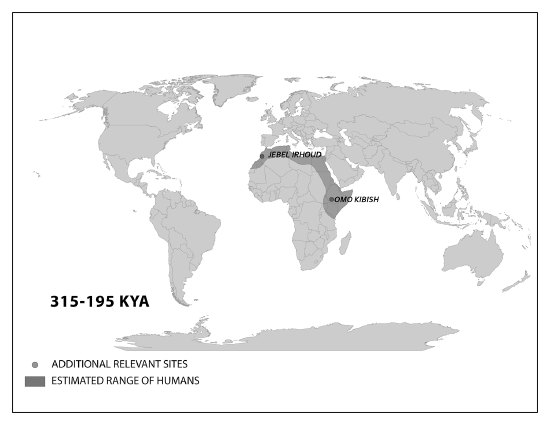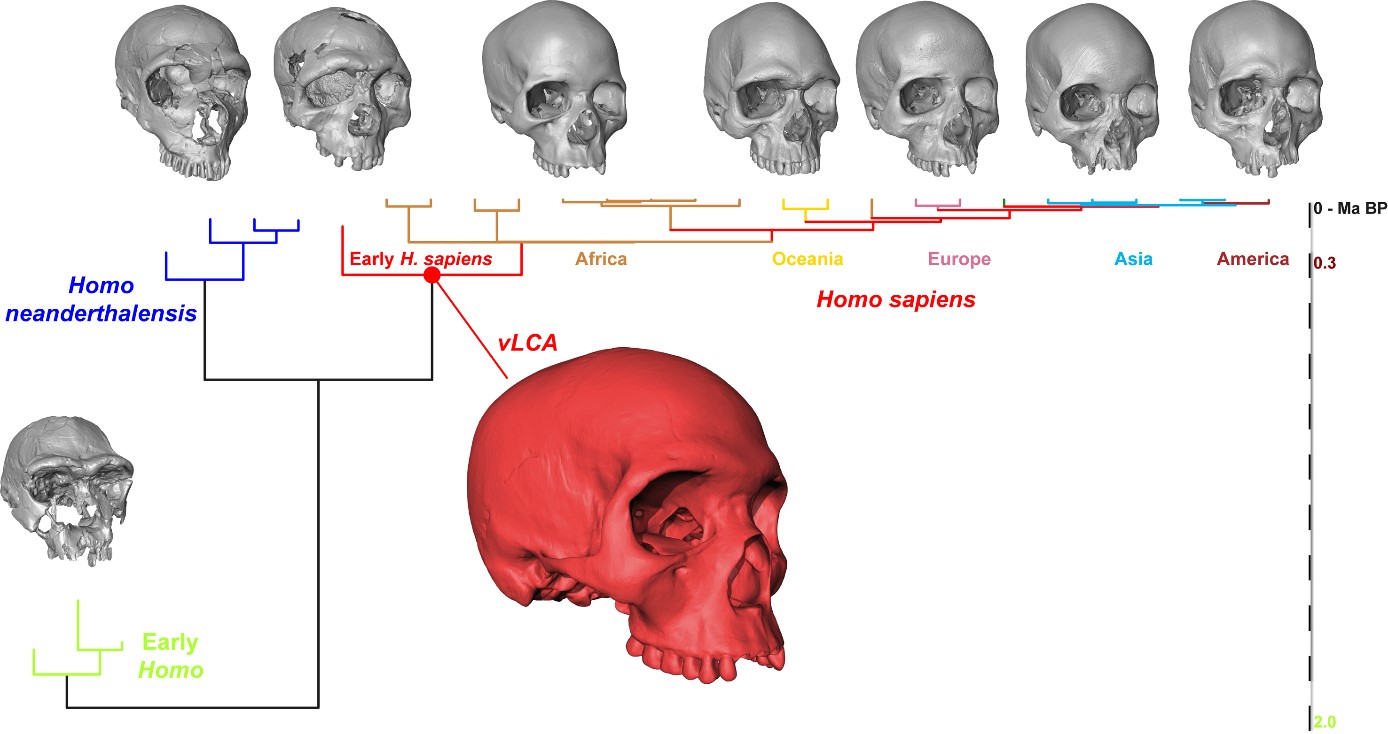With Modern Homo Sapiens Appearance In The Late Pleistocene
Anatomically modern human AMH refers to early individuals of Homo sapiens with an appearance fully congruent with that of modern humans. It is intended to be the fourth division of the Pleistocene Epoch within the ongoing Quaternary Period.
 Pin On A History Of Life In 10 Fossils
Pin On A History Of Life In 10 Fossils
The Upper Paleolithic also called the Late Stone Age is the third and last subdivision of the Paleolithic or Old Stone Age.

With modern homo sapiens appearance in the late pleistocene. Bones occur with Acheulean bifaces and Levallois flakes in the Upper Herto sand unit judged from stratigrapic geochemical and radioisotopic evidence to be 160000 to 154000 years old 25. Early modern human or anatomically modern human AMH are terms used to distinguish Homo sapiens that are anatomically consistent with the range of phenotypes seen in contemporary humans from extinct archaic human species. 120000 - 125000 years ago suspiciously coincides with the consensus date estimate of several genetic studies for the origin of modern Homo sapiens The last refinements on language and improvements in technology may have occurred and been a.
Denisova hominin live in the Altai Mountains Russia. The site also preserves a rich mainly Late Pleistocene mammal fauna representative of the Florisian Land Mammal Age in southern Africa. Fossils from Herto in the Middle Awash region confirm the presence of H.
The emergence of anatomically modern human marks the dawn of the subspecies Homo sapiens sapiens ie. Earliest evidence of modern humans found in Europe in Southern Italy. Very broadly it dates to between 50000 and 12000 years ago according to some theories coinciding with the appearance of behavioral modernity in early modern humans until the advent of the Neolithic Revolution and agriculture.
Persals out of Africa best explain the Late Pleistocene human evolutionary record in eastern Asia. This is in the late Pleistocene Epoch. Late surviving populations of archaic Homo sapiens and Homo heidelbergensis lived alongside early modern Homo sapiens before disappearing from the fossil record by about 100000 years ago.
The spring site of Florisbad in the Free State preserves the important cranial remains of an individual Homo helmei considered to be Middle Pleistocene in age and possibly a later archaic form of H. The chronological overlap between modern and more primitive morphs in the late Middle Pleistoceneearly Middle Stone Age fossil record from Africa suggests that the appearance of H. Among the oldest known remains of Homo sapiens are from Omo-Kibish I dating to about 196000 years ago Florisbad dating t.
It is currently estimated to span the time between c. The Neandertals adapted physically and culturally to the ice age conditions that prevailed during much of their time. If we restrict the use of Homo sapiens in the fossil record to specimens which share a significant number of derived features in the skeleton with extant H.
Early cultural center in the Swabian Alps. Sapiens to which all modern humans belong evolved in the later part of the middle Pleistocene and early forms of the species are known from about 400000 years ago. It is likely that the Neandertals evolved from Homo heidelbergensis in Southern Europe.
The subspecies of Homo sapiens that includes all modern humans. Sapiens Neanderthals was slightly smaller than in early anatomically modern humans but the major increase in encephalization within Homo. Excavations in the late Pleistocene deposits at Liang Bua cave Flores have uncovered the skeletal remains of several small-bodied and small-brained hominins in association with stone artefacts and the bones of Stegodon.
This distinction is useful especially for times and regions where anatomically modern and archaic humans co-existed for example in Paleolithic Europe. For instance based on a purported absence of hominin fossils Jin and Su 2000 arguedthatmid-Pleistocene Homo wentextinctinChinaaround. Anatomically modern humans are believed to have emerged in Africa around 300000 years ago although it has been argued by some that these lifest.
At Ksar Akil in Lebanon ornaments and skeletal remains of modern humans are dated to this period. Key specimens that reveal an evolutionary transition from archaic to modern Homo sapiens include Florisbad cranium LH18 from Laetoli Omo 1 and 2 from Omo-Kibish Herto skull from Ethiopia and Skhul 5 from Israel. According to traditional models MHS did not arrive in eastern Asia until after 50 ka Klein 2008.
Neandertal-like skull characteristics have been found in 4 00000 year old fossils from Spain. The Late Pleistocene equates to the proposed Tarantian Age of the geologic time scale preceded by the officially ratified Chibanian and s. Sapiens in northeastern Africa late in the Middle Pleistocene.
Due to their combination of plesiomorphic unique and derived traits they were ascribed to a new species Homo floresiensis which along with Stegodon appears to have become extinct 17 ka thousand years ago. Sapiens features Late Pleistocene Happenings The warm peak of the last interglacial ca. Sapiens in the continent cannot be seen as a simple linear progression toward the typical present-day populations Stringer and Barnes 2015.
During the late middle Pleistocenebetween 400 000 and 150 0000 years agothe populations occupying Earth and Africa specifically looked very differently from what they do now. Sapiens the origin of our species would be placed in the African late middle Pleistocene based on fossils such as Omo Kibish 1 Herto 1 and 2 and the Levantine material from Skhul and Qafzeh. For Late Pleistocene African populations of modern humans the constellation of behavioral changes encapsulated in the transition from the Middle Stone Age MSA to the Later Stone Age LSA 7020 kya represents a series of some of the most pronounced changes in the archaeological record before the adoption of domesticated animals and plants and the use of ceramics for cooking and storage.
The Late Pleistocene is an unofficial age in the international geologic timescale in chronostratigraphy also known as Upper Pleistocene from a stratigraphic perspective. Anatomically modern humans evolved from archaic Homo sapiens in the Middle Paleolithic about 200000 years ago. Relative to body mass brain mass in late archaic H.
High profile genetic fossil and material culture discoveries present scientists working in the Late Pleistocene with an ever-more complex picture of interactions between early hominin populations.
Modern Homo Sapiens Explorations
Modern Homo Sapiens Explorations
 On The Origin Of Modern Humans Asian Perspectives Science
On The Origin Of Modern Humans Asian Perspectives Science
 19 Lateral View Of Anatomically Modern Homo Sapiens Cranium Is 1 1 From Download Scientific Diagram
19 Lateral View Of Anatomically Modern Homo Sapiens Cranium Is 1 1 From Download Scientific Diagram
Modern Homo Sapiens Explorations
Modern Homo Sapiens Explorations
Geol 204 The Fossil Record Last Man Standing The Rise Of Homo Sapiens
 Evolution Of Modern Humans Homo Heidelbergensis
Evolution Of Modern Humans Homo Heidelbergensis
 12 2 First Africa Then The World Social Sci Libretexts
12 2 First Africa Then The World Social Sci Libretexts
Modern Homo Sapiens Explorations
 The Rise Of Anatomically Modern Homo Sapiens Human Evolution Anth 121 Docsity
The Rise Of Anatomically Modern Homo Sapiens Human Evolution Anth 121 Docsity
 What Noggin Of Modern Humans Ancestor Would Have Looked Like Cnrs
What Noggin Of Modern Humans Ancestor Would Have Looked Like Cnrs
Modern Homo Sapiens Explorations
Modern Homo Sapiens Explorations
 Anatomically Modern Homo Sapiens Sciencedirect
Anatomically Modern Homo Sapiens Sciencedirect
 On The Origin Of Modern Humans Asian Perspectives Science
On The Origin Of Modern Humans Asian Perspectives Science
 The Rise Of Archaic Homo Sapiens Articles Biologos
The Rise Of Archaic Homo Sapiens Articles Biologos


0 Response to "With Modern Homo Sapiens Appearance In The Late Pleistocene"
Post a Comment